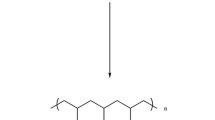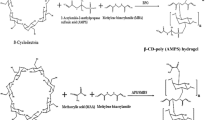Abstract
Hydrogels based on pH-sensitive polymers are of great interest as potential biomaterials for the controlled delivery of drug molecules. In this study, a novel pH-sensitive copolymer hydrogel based on acrylic acid (AA) monomer by free-radical solution polymerization were synthesized with organic–inorganic cross-linking agent of octavinyl polyhedral oligomeric silsesquioxane (OVPOSS). And its properties were compared with conventional hydrogels using N,N′-methylenebisacrylamide (MBA) as cross-linking agent. The copolymers were characterized by Fourier transform infrared spectra and differential scanning calorimetry. The morphology after swelling was presented by scanning electron microscopy. Swelling behaviors in different pH and potential applications in controlled drug delivery of the hydrogels were also examined. The results showed that both hydrogels were pH sensitive. However, as the addition of OVPOSS limited the movement of the molecular chain segment, the swelling ratio and the drug-release rate of theophylline in SGF decreased obviously when using OVPOSS as cross-linking agent, comparing with P(MBA-co-AA) hydrogels. The results in this study suggested that P(OVPOSS-co-AA) could serve as potential candidate for theophylline drug delivery.







Similar content being viewed by others
References
Wang K, Xu X, Wang YJ, Yan X, Guo G, Huang MJ, Luo F, Zhao X, Wei YQ, Qian ZY (2010) Synthesis and characterization of poly(methoxyl ethylene glycol-caprolactone-co-methacrylic acid-co-poly(ethylene glycol) methyl ether methacrylate) pH-sensitive hydrogel for delivery of dexamethasone. Int J Pharm 389:130–138
Liu CH, Chen YQ, Chen JG (2010) Synthesis and characteristics of pH-sensitive semi-interpenetrating polymer network hydrogels based on konjac glucomannan and poly(aspartic acid) for in vitro drug delivery. Carbohydr Polym 79:500–506
Singh TRR, Garland MJ, Migalska K, Salvador EC, Shaikh R, McCarthy HO, Woolfson AD, Donnelly RF (2012) Influence of a pore-forming agent on swelling, network parameters, and permeability of poly(ethylene glycol)-crosslinked poly(methyl vinyl ether-co-maleic acid) hydrogels: application in transdermal delivery systems. J Appl Polym Sci 125:2680–2694
Li SF, Yang YJ, Li HB, Yang XL, Xu HB (2007) pH-responsive semi-interpenetrating networks hydrogels of poly(acrylic acid-acrylamide-methacrylate) and amylose. I. synthesis and characterization. J Appl Polym Sci 106:3792–3799
Carmen A-L, Angel C (2002) Reversible adsorption by a pH- and temperature-sensitive acrylic hydrogel. J Control Release 80:247–257
Zhang JT, Xue YN, Gao FZ, Huang SW, Zhuo RX (2008) Preparation of temperature-sensitive poly(-isopropylacrylamide)/b-cyclodextrin-grafted polyethylenimine hydrogels for drug delivery. J Appl Polym Sci 108:3031–3037
Mee RK, Tae GP (2002) Temperature-responsive and degradable hyaluronic acid/pluronic composite hydrogels for controlled release of human growth hormone. J Control Release 80:69–77
Zhang XZ, Sun GM, Chu CC (2004) Temperature sensitive dendrite-shaped PNIPAAm/Dex-AI hybrid hydrogel particles: formulation and properties. Eur Polym J 40:2251–2257
Azab AK, Orkin B, Doviner V, Nissan A, Klein M, Srebnik M, Rubinstein A (2006) Crosslinked chitosan implants as potential degradable devices for brachytherapy: in vitro and in vivo analysis. J Control Release 111:281–289
Li F, Ying Z, Tian WT (2006) Preparation and water absorbent behavior of superabsorbent polyaspartic acid resin. J Polym Res 13:145–152
Murdan S (2003) Electro-responsive drug delivery from hydrogels. J Control Release 92:1–17
Tomer R, Dimitrijevic D, Florence AT (1995) Electrically controlled release of macromolecules from cross-linked hyaluronic acid hydrogels. J Control Release 33:405–413
Kim J, Lee K-W, Hefferan TE, Currier BL, Yaszemski MJ, Lu L (2008) Synthesis and evaluation of novel biodegradable hydrogels based on poly(ethylene glycol) and sebacic acid as tissue engineering scaffolds. Biomacromolecules 9:149–157
Tan H, Chu CR, Marra KG (2009) Injectable in situ forming biodegradable chitosan–hyaluronic acid based hydrogels for cartilage tissue engineering. Biomaterials 30:2499–2506
Kim JO, Park JK, Kim JH, Jin SG, Yong CS, Li DX, Choi JY, Woo JS, Yoo BK, Lyoo WS, Kim J-A, Choi H-G (2008) Development of polyvinyl alcohol–sodium alginate gel-matrix-based wound dressing system containing nitrofurazone. Int J Pharm 359:79–86
Kokabi M, Sirousazar M, Hassan ZM (2007) PVA–clay nanocomposite hydrogels for wound dressing. Eur Polym J 43:773–781
Subramanian K, Vijayakumar V (2013) Evaluation of isophorone diisocyanate crosslinked gelatin as a carrier for controlled delivery of drugs. Polym Bull 70:733–753
Katime I, Sáez V, Hernáez E (2005) Nafcillin release from poly(acrylic acid–co–methylmethacrylate) hydrogels. Polym Bull 55:403–409
Şen M, Kantoğlu Ö, Güven O (1999) The effect of external stimuli on the equilibrium swelling properties of poly(N-vinyl 2-pyrrolidone/itaconic acid) poly-electrolyte hydrogels. Polymer 40:913–917
Sousa A, Maria DA, Sousa RG, Sousa EM (2010) Synthesis and characterization of mesoporous silica/poly(N-isopropylacrylamide) functional hybrid useful for drug deliver. B J Mater Sci 45:1478–1486
Zhang NY, Liu MZ, Shen YG, Chen J, Dai LL, Gao CM (2011) Preparation, properties, and drug release of thermo- and pH-sensitive poly((2-dimethylamino)ethyl methacrylate)/poly(N, N-diethylacrylamide) semi-IPN hydrogels. J Mater Sci 46:1523–1534
Needleman IG, Smales FC (1995) In V&-D assessment of bioadhesion for periodontal and buccal drug delivery. Biomaterials 16:617–624
Ramkissoon-Ganorkar C, Liu F, Baudyš M, Kim S (1999) Modulating insulin-release profile from pH/thermosensitive polymeric beads through polymer molecular weight. W J Control Release 59:287–298
Sinha VR, Kumria R (2001) Polysaccharides in colon-specific drug delivery. Int J Pharm 224:19–38
Haraguchi BK, Takehsia T (2002) Nanocomposite hydrogels: a unique organic-inorganic network structure with extraordinary mechanical, optical, and swelling/de-swelling. Adv Mater 14:1120–1124
Jr CUP, Li G-Z, Ni H (2003) Hybrid inorganic/organic crosslinked resins containing polyhedral oligomeric silsesquioxanes. Macromo Symp 196:301–325
Li GZ, Wang LC, Ni HL, CUP Jr (2002) Polyhedral oligomeric silsesquioxane (POSS) polymers and copolymers: a review. J Inorg Organomet Polym 11:123–154
Harrison PG (1997) Silicate cages: precursors to new materials. Organomet Chem 542:141–183
Prasanth VV, Mitesh PM, Sam TM, Abin A (2012) Formulation and evaluation of enteric coated time release press coated tablets of theophylline for chronopharmacotherapy. Der Pharmacia Lettre 4:599–606
Kadono K, Yokoe J-I, Ogawara K-I, Higaki K, Kimura T (2002) Analysis and prediction of absorption behavior for theophylline orally administered as powders based on gastrointestinal-transit-absorption (gita) model. Drug Metabol Pharmacok 17:307–315
Luo YL, Zhang KP, Wei QB, Liu ZQ, Chen YS (2009) Poly(MAAcoAN) hydrogels with improved mechanical properties for theophylline controlled delivery. Acta Biomater 5:316–327
Peniche C, Cohen ME, Vázquez B, Román JS (1997) Water sorption of flexible networks based on 2-hydroxyethyl methacrylate-triethylenglycol dimethacrylate. Copolymers. Polymer 38:5977–5982
Acknowledgments
Financial support was provided by the International Cooperative Project of Jilin Provincial Science and Technology Department (No. 20130413048GH) and the International Cooperative Project of Science and Technology Bureau of Changchun (No. 2010064). Partial support from Natural Science Foundation of China was also acknowledged (Project No. 51003037).
Author information
Authors and Affiliations
Corresponding author
Rights and permissions
About this article
Cite this article
Huang, D., Zhang, C., Yu, K. et al. Preparation of a novel pH-sensitive hydrogel based on acrylic acid and polyhedral oligomeric silsesquioxane for controlled drug release of theophylline. Polym. Bull. 71, 1877–1889 (2014). https://doi.org/10.1007/s00289-014-1161-y
Received:
Revised:
Accepted:
Published:
Issue Date:
DOI: https://doi.org/10.1007/s00289-014-1161-y




